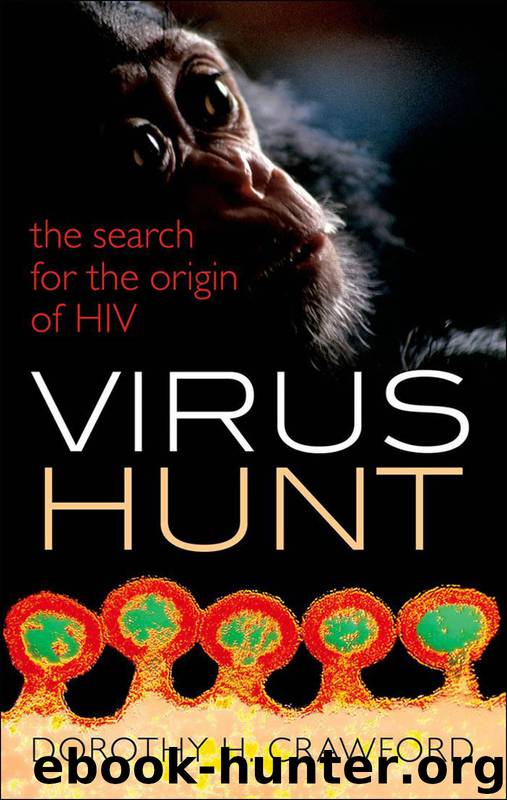Virus Hunt by Crawford Dorothy H.;

Author:Crawford, Dorothy H.;
Language: eng
Format: epub
Publisher: Oxford University Press USA - OSO
Published: 2013-08-03T16:00:00+00:00
6
Vital First Steps
In solving the mystery of the origin of HIV-1 we have established what the AIDS agent is, when and where it first infected humans, who or what the virus derived from and how it spread. Now in the next two chapters we look at evidence for how the virus jumped from chimpanzees to humans and why it succeeded in spreading.
As soon as HIV-1 was discovered as the cause of AIDS in the early 1980s, theories about its origin abounded. But, excluding the outrageous, the incredible, the scientifically unsound, and the conspiracy theories, some of which are mentioned in chapter 2, what we are looking for is a feasible mechanism of virus transfer. This must assimilate all the facts about HIV-1 uncovered since its discovery and outlined in earlier chapters. By the year 2000 it was generally accepted that viruses ancestral to HIV-1 groups M, N, and O came from chimpanzees of the subspecies P.t.troglodytes. As these animals live exclusively in west central Africa, virus transfer is most likely to have occurred somewhere in this geographic region.
We shall probably never discover the exact circumstances of HIV-1’s momentous leap, but since we know that the ancestors of each of the virus’s main groups jumped from chimpanzees (and possibly gorillas) to humans independently, such inter-species transfer may be rare, but it is certainly not a unique event. We know that HIV-2 has made at least eight separate jumps from sooty mangabeys to humans, so these plus the four HIV-1 groups we have uncovered so far may represent just the tip of the iceberg. Perhaps SIVs have jumped to humans many times in the past but have either failed to take hold in their new host or were unable to establish a chain of infection. Either way, the virus would eventually have become extinct and the infection have remained unrecognized.
Inside their natural hosts, SIVs circulate in the blood and lodge in blood-rich organs such as the gut, lymph glands, spleen, and brain. These viruses are also present, albeit at a much lower level, in mucosal secretions like semen, breast milk, and possibly saliva, and so transmission between animals of the same species could occur through contact with one of these body fluids from an infected animal. However, since exposure to virus-containing mucosal secretions is a much less efficient route of virus transmission than direct exposure to infected blood or blood-rich organs, it is generally assumed that inter-species transmission such as ancestral HIV-1’s successful jumps to their new human host were via contact with blood from SIVcpz- carrying chimpanzees.
The most obvious human pursuit that involves regular contact with animal blood is hunting. In Africa, where modern man evolved around 100,000 years ago, our hominid ancestors have been hunting, killing, butchering, and eating animals for millions of years. Exactly when they developed the skill to make hunting tools of sufficient sophistication to allow large, non-human primates to be added to their diet is not entirely clear, although if the animals were old or sick they might provide easy prey.
Download
This site does not store any files on its server. We only index and link to content provided by other sites. Please contact the content providers to delete copyright contents if any and email us, we'll remove relevant links or contents immediately.
| Administration & Medicine Economics | Allied Health Professions |
| Basic Sciences | Dentistry |
| History | Medical Informatics |
| Medicine | Nursing |
| Pharmacology | Psychology |
| Research | Veterinary Medicine |
The Immortal Life of Henrietta Lacks by Rebecca Skloot(4257)
An American Plague by Jim Murphy(3629)
The Emperor of All Maladies: A Biography of Cancer by Siddhartha Mukherjee(2930)
The Gene: An Intimate History by Siddhartha Mukherjee(2927)
The Fate of Rome: Climate, Disease, and the End of an Empire (The Princeton History of the Ancient World) by Kyle Harper(2872)
Rebecca Skloot by The Immortal Life of Henrietta Lacks(1881)
Stiff - The Curious Lives of Human Cadavers by Mary Roach(1735)
The Great Influenza by John M Barry(1710)
The Vaccine Race by Meredith Wadman(1559)
Undue Risk by Moreno Jonathan D.;(1519)
Three Cups of Tea by Greg Mortenson(1515)
The Mystery of the Exploding Teeth by Thomas Morris(1486)
Quackery by Lydia Kang(1485)
Hero by Michael Grant(1470)
Autism's False Prophets by Paul A. Offit(1448)
A Journal of the Plague Year (Oxford World's Classics) by Daniel Defoe(1440)
Steroids: History, Science, and Issues by Standora Joan E.; Bogomolnik Alex; Slugocki Malgorzata(1426)
Extremes: Life, Death and the Limits of the Human Body by Fong Kevin(1418)
The Vaccine Court by Rohde Wayne(1412)
